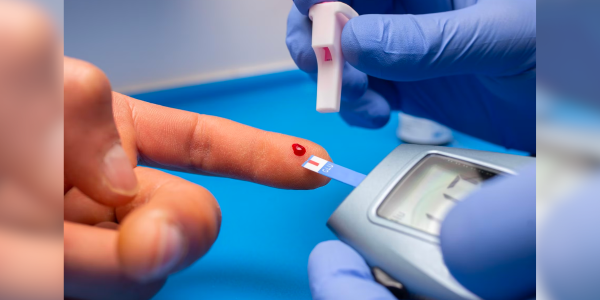Health advocate reveals alarming signs you could be on the path towards diabetes!
By
VanessaC
- Replies 2
As we age, our bodies tend to become more susceptible to long-term health problems.
That’s why it’s important to listen to what your body is trying to tell you and take proactive measures to ensure you stay healthy.
Former personal trainer and health advocate Rav Malik has warned people to be aware of the physical signs of developing type 2 diabetes.
In the year 2021, the prevalence of type 2 diabetes according to linked data from the National Diabetes Services Scheme (NDSS) and Australasian Paediatric Endocrine Group (APEG), increased as people age.
Among those living with type 2 diabetes in Australia (almost 1.2 million), 3.1 per cent of which are under 40 years old. While more than half (59 per cent) are aged 65 years and above.
This type of diabetes usually appears at age 45 but may still occur at any age. It is most common among 45-64 years olds.
He shared that the body actually presents several signs of insulin resistance before one is diagnosed with diabetes.
Insulin resistance is a clinical condition where insulin, a hormone secreted by the pancreas to control blood glucose levels, no longer works as efficiently as it should.
The hormone has a direct effect on the body’s ability to burn fat and lose weight, hence, if one is insulin resistant, they would usually find it more difficult to lose weight.
To ensure that insulin levels remain within the safe range, lessening one’s intake of processed sugars and refocusing diet to include more protein is recommended.
So, what are the telltale signs you’re heading towards type 2 diabetes—and more importantly, what can you do to take control of your health?
According to Malik, some of the most common signs of insulin resistance—and subsequently, the pre-diabetic stage—include cracks on the back of the neck, skin tags and pigmentation, and swollen feet.
Another symptom is if your belly fat is 'hard' and 'dense' rather than soft.
'If you touch your stomach fat and it's hard and dense—you're insulin resistant because the body is stuck in storage mode,' he said.
'Your feet will also start to swell because your body is retaining water and your blood pressure is higher.'
'Your neck will get fatter and make it difficult for you to sleep, and you may even develop sleep apnea.'
Another sign of insulin resistance may be having 'flabby' arms.
Now, you might be wondering how people develop insulin resistance.
According to Rav: 'Our body is so tightly regulated, so whenever we eat food it increases our blood sugar.'
A meal with high sugar like cereal will increase the insulin levels in the body by a significant amount, which will make it longer for it to come back down to its base level.
'It makes you hungry, tired, and want to eat more—but here's where the problem lies,' he continued.
'If you're constantly eating lots of sugar—your insulin doesn't go down and your body starts to become resistant to it.'
This can cause hyperinsulinemia, which happens when the amount of insulin in the blood is higher than what is considered healthy.
'The new normal leads to sickness—you start experiencing the physical symptoms but you also start looking older, craving sugar, feeling intense hunger, and have difficulty concentrating.'
Below are some symptoms of type 2 diabetes and a list of those at risk of having diabetes:

Many expressed their gratitude to Rav for sharing his knowledge, with one saying: 'Wow, I didn't know there were so many signs to look out for. I'm going to do a physical check before visiting my doctor—thank you!'
While another said: 'I knew I should be concerned about the sudden pigmentation—thanks for sharing.'

 Members, will you be staying away from too much sugar after this? Let us know in the comments below!
Members, will you be staying away from too much sugar after this? Let us know in the comments below!
That’s why it’s important to listen to what your body is trying to tell you and take proactive measures to ensure you stay healthy.
Former personal trainer and health advocate Rav Malik has warned people to be aware of the physical signs of developing type 2 diabetes.
In the year 2021, the prevalence of type 2 diabetes according to linked data from the National Diabetes Services Scheme (NDSS) and Australasian Paediatric Endocrine Group (APEG), increased as people age.
Among those living with type 2 diabetes in Australia (almost 1.2 million), 3.1 per cent of which are under 40 years old. While more than half (59 per cent) are aged 65 years and above.
This type of diabetes usually appears at age 45 but may still occur at any age. It is most common among 45-64 years olds.
He shared that the body actually presents several signs of insulin resistance before one is diagnosed with diabetes.
Insulin resistance is a clinical condition where insulin, a hormone secreted by the pancreas to control blood glucose levels, no longer works as efficiently as it should.
The hormone has a direct effect on the body’s ability to burn fat and lose weight, hence, if one is insulin resistant, they would usually find it more difficult to lose weight.
To ensure that insulin levels remain within the safe range, lessening one’s intake of processed sugars and refocusing diet to include more protein is recommended.
So, what are the telltale signs you’re heading towards type 2 diabetes—and more importantly, what can you do to take control of your health?
According to Malik, some of the most common signs of insulin resistance—and subsequently, the pre-diabetic stage—include cracks on the back of the neck, skin tags and pigmentation, and swollen feet.
Another symptom is if your belly fat is 'hard' and 'dense' rather than soft.
'If you touch your stomach fat and it's hard and dense—you're insulin resistant because the body is stuck in storage mode,' he said.
'Your feet will also start to swell because your body is retaining water and your blood pressure is higher.'
'Your neck will get fatter and make it difficult for you to sleep, and you may even develop sleep apnea.'
Another sign of insulin resistance may be having 'flabby' arms.
Now, you might be wondering how people develop insulin resistance.
According to Rav: 'Our body is so tightly regulated, so whenever we eat food it increases our blood sugar.'
A meal with high sugar like cereal will increase the insulin levels in the body by a significant amount, which will make it longer for it to come back down to its base level.
'It makes you hungry, tired, and want to eat more—but here's where the problem lies,' he continued.
'If you're constantly eating lots of sugar—your insulin doesn't go down and your body starts to become resistant to it.'
This can cause hyperinsulinemia, which happens when the amount of insulin in the blood is higher than what is considered healthy.
'The new normal leads to sickness—you start experiencing the physical symptoms but you also start looking older, craving sugar, feeling intense hunger, and have difficulty concentrating.'
Below are some symptoms of type 2 diabetes and a list of those at risk of having diabetes:
Many expressed their gratitude to Rav for sharing his knowledge, with one saying: 'Wow, I didn't know there were so many signs to look out for. I'm going to do a physical check before visiting my doctor—thank you!'
While another said: 'I knew I should be concerned about the sudden pigmentation—thanks for sharing.'
Tip
Please note that this article cannot be considered medical advice. It is best to consult a health practitioner before changing your diet and for a more accurate diagnosis.
Key Takeaways
- Health advocate Rav Malik has detailed the physical signs that could indicate your body is developing type 2 diabetes.
- These signs include a hard and dense belly, skin changes like skin tags and pigmentation, swollen feet, and 'flabby' arms.
- One major reason people develop insulin resistance, which leads to diabetes, is the overconsumption of processed sugars.








